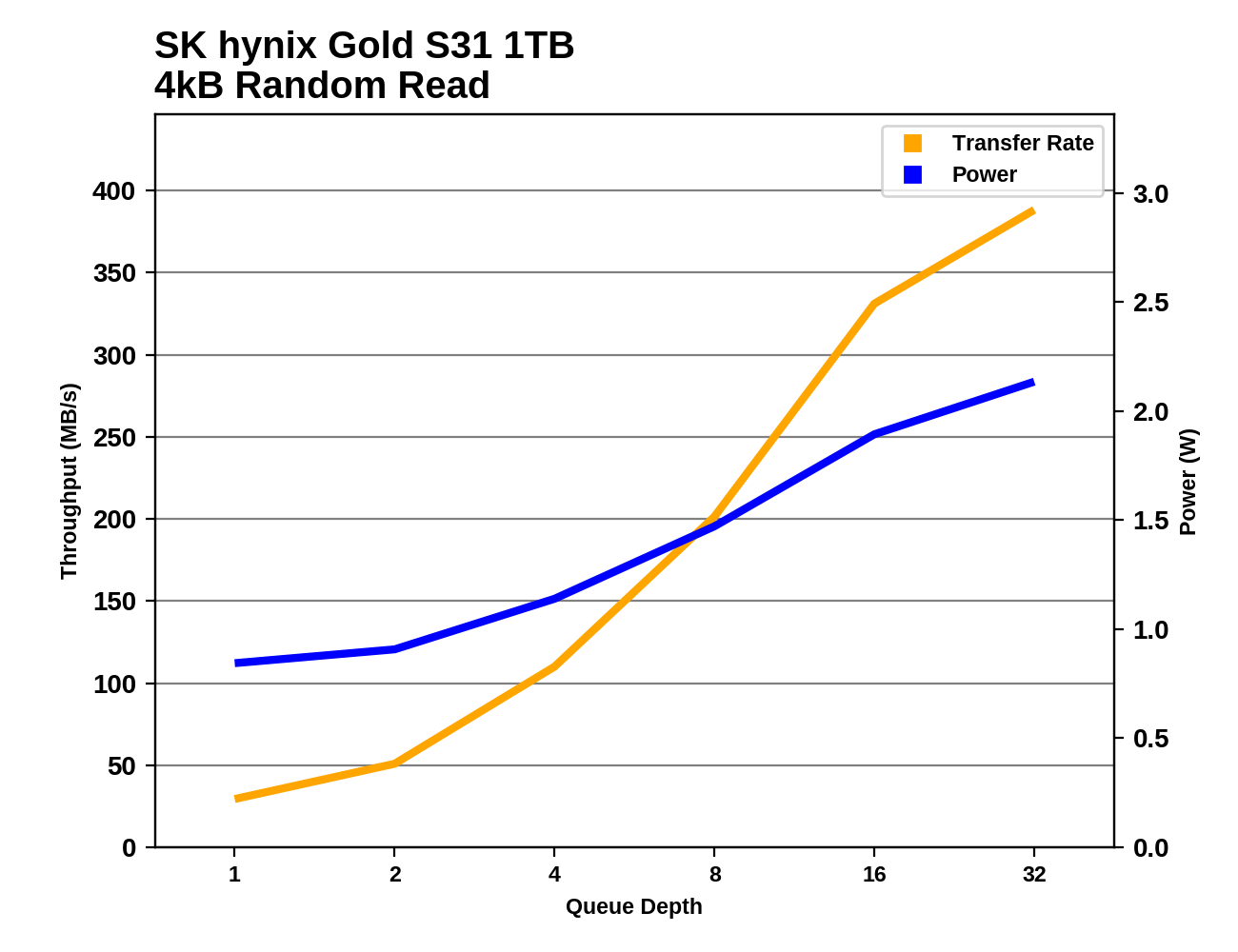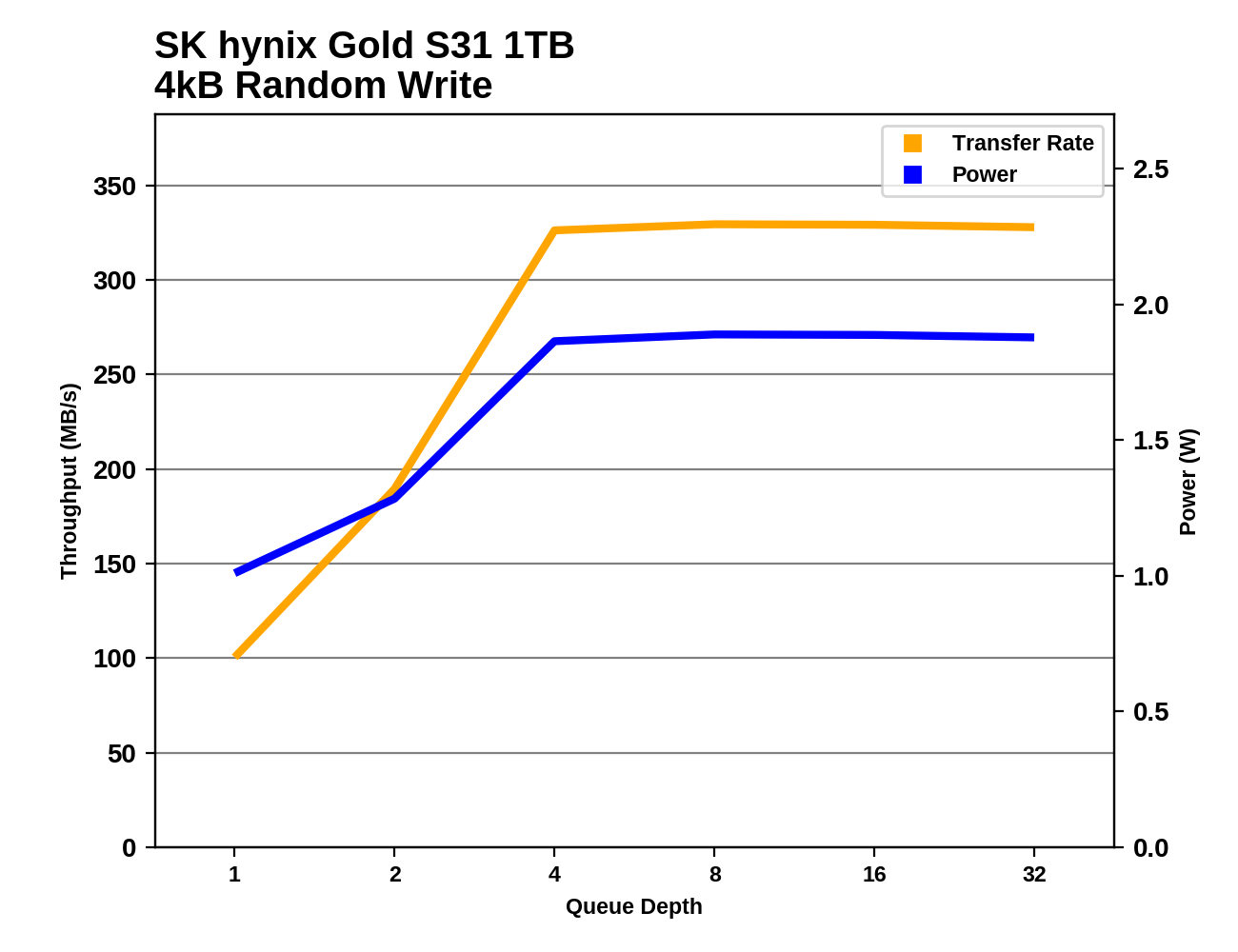The SK Hynix Gold S31 SATA SSD Review: Hynix 3D NAND Finally Shows Up
by Billy Tallis on November 13, 2019 12:00 PM ESTRandom Read Performance
Our first test of random read performance uses very short bursts of operations issued one at a time with no queuing. The drives are given enough idle time between bursts to yield an overall duty cycle of 20%, so thermal throttling is impossible. Each burst consists of a total of 32MB of 4kB random reads, from a 16GB span of the disk. The total data read is 1GB.

The burst random read performance of the SK Hynix Gold S31 isn't great: it's more in line with what we see from DRAMless SSDs than from most recent mainstream TLC-based drives.
Our sustained random read performance is similar to the random read test from our 2015 test suite: queue depths from 1 to 32 are tested, and the average performance and power efficiency across QD1, QD2 and QD4 are reported as the primary scores. Each queue depth is tested for one minute or 32GB of data transferred, whichever is shorter. After each queue depth is tested, the drive is given up to one minute to cool off so that the higher queue depths are unlikely to be affected by accumulated heat build-up. The individual read operations are again 4kB, and cover a 64GB span of the drive.

On the longer random read test, the S31s are clearly ahead of the DRAMless and QLC drives, but still a bit slower than typical for a mainstream SATA drive.
 |
|||||||||
| Power Efficiency in MB/s/W | Average Power in W | ||||||||
The SK Hynix Gold S31s all provide excellent power efficiency during the random read test; they draw only slightly more power than the DRAMless Toshiba TR200, and much less power than any of the mainstream SATA SSDs in this comparison. The MLC-based Samsung 860 PRO is the only drive in this batch that delivers a better performance per Watt ratio, which it achieves by being about 30% faster than the TLC drives while consuming similar amounts of power.
 |
|||||||||
The 250GB S31's random read performance starts to fall behind the 1TB model with queue depths higher than about 4, while the 500GB more or less keeps pace through QD8. Compared to competing mainstream TLC drives from Samsung, Crucial and WD/SanDisk, the 1TB S31's performance never falls far behind, but its power consumption is almost always lower, often by a significant amount.
Plotting the S31's performance and power usage during the random read test against all the other SATA drives we've tested reveals that the S31 doesn't quite break the power efficiency record, but it comes pretty close except at the highest queue depths.
Random Write Performance
Our test of random write burst performance is structured similarly to the random read burst test, but each burst is only 4MB and the total test length is 128MB. The 4kB random write operations are distributed over a 16GB span of the drive, and the operations are issued one at a time with no queuing.

As with random reads, the burst random write performance of the SK Hynix Gold S31 is a bit slower than the competition, but this time the deficit is definitely smaller.
As with the sustained random read test, our sustained 4kB random write test runs for up to one minute or 32GB per queue depth, covering a 64GB span of the drive and giving the drive up to 1 minute of idle time between queue depths to allow for write caches to be flushed and for the drive to cool down.

On the longer random write test, the 500GB and 1TB models of the S31 perform similarly and are competitive with everything but the Samsung drives. The 250GB model is 25% slower than the 500GB, which still leaves it substantially faster than the DRAMless or QLC-based drives.
 |
|||||||||
| Power Efficiency in MB/s/W | Average Power in W | ||||||||
The S31 again uses less power than other mainstream SATA drives, and that allows the larger two models to turn in efficiency scores that are second only to Samsung's high-end options. The slower 250GB model's efficiency score is comparable to some of the better 500GB and 1TB competitors.
 |
|||||||||
The 1TB and 500GB S31s hit full random write speed at QD4, and maintain that performance through the rest of the test without any trouble. The 250GB model saturates a bit earlier and even at QD2 is pretty close to its maximum random write throughput, but at least it too is steady and well-behaved for the rest of the test.
Plotting the results against the entire archive of SATA tests, the 1TB S31 again isn't setting any new efficiency record, but it is definitely one of the most power-efficient SATA drives for a random write workload.












22 Comments
View All Comments
jabber - Friday, November 15, 2019 - link
I think the thing is we are now at the point of diminishing returns. I find it hard to tell the everyday difference between running a desktop on a 550MBps SATA or a 3000MBps NVMe (NVMe was a real disappointment for the boost it gives). 20+ years ago if I got another 5FPS in Quake I could tell. Now if my games jump from 130FPS to 140FPS...meh.I was upgrading my CPU every 6 months at one point many years ago. Now it's lucky if i change it every 6 years...
Samus - Friday, November 15, 2019 - link
Actually a pretty impressive drive. The steady state performance is excellent. When I'm pushing out images to new PC's it's ridiculous a lot of the SSD's bottleneck even the network connection (which is realistically around 160MB/sec via (1Gbps Multicast) as you see it write VERY fast for the first half of a 15GB image then fall off.Imaging over USB 3.0 is totally brutal and only slightly faster than via the network. The SSD's are a mix of Intel OEM 540/545s drives and Micron 1100/1300 OEM drives, depending on the vendor. HP seems to use the Intel and Dell the Micron's. They're such shit all around drives for my job, but as you can imagine the users don't care because they're writing maybe a few GB a day via Outlook OST caching and general paging in Windows.